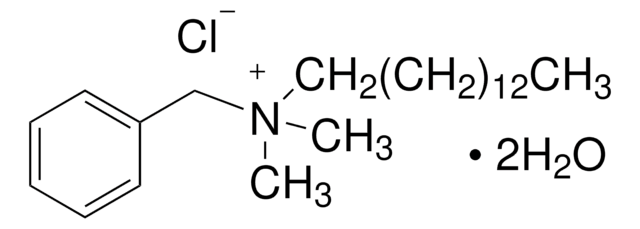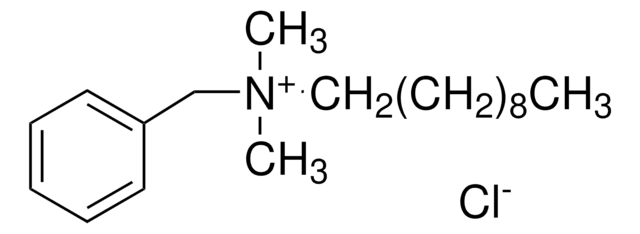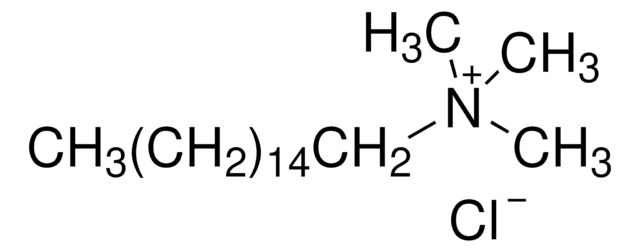B4136
Benzyldimethylhexadecylammonium chloride
cationic detergent
Synonyme(s) :
16-BAC, Benzylhexadecyldimethylammonium chloride, Cetalkonium chloride, Cetyldimethylbenzylammonium chloride
About This Item
Produits recommandés
Niveau de qualité
Forme
powder
Poids mol.
396.09 g/mol
Pf
55-65 °C (lit.)
Température de stockage
room temp
Chaîne SMILES
[Cl-].CCCCCCCCCCCCCCCC[N+](C)(C)Cc1ccccc1
InChI
1S/C25H46N.ClH/c1-4-5-6-7-8-9-10-11-12-13-14-15-16-20-23-26(2,3)24-25-21-18-17-19-22-25;/h17-19,21-22H,4-16,20,23-24H2,1-3H3;1H/q+1;/p-1
Clé InChI
SXPWTBGAZSPLHA-UHFFFAOYSA-M
Vous recherchez des produits similaires ? Visite Guide de comparaison des produits
Description générale
Application
Mention d'avertissement
Danger
Mentions de danger
Conseils de prudence
Classification des risques
Acute Tox. 4 Oral - Aquatic Acute 1 - Aquatic Chronic 1 - Eye Dam. 1 - Skin Corr. 1B
Code de la classe de stockage
8A - Combustible corrosive hazardous materials
Classe de danger pour l'eau (WGK)
WGK 2
Point d'éclair (°F)
143.6 °F - Pensky-Martens closed cup
Point d'éclair (°C)
62 °C - Pensky-Martens closed cup
Équipement de protection individuelle
Eyeshields, Faceshields, Gloves, type P3 (EN 143) respirator cartridges
Faites votre choix parmi les versions les plus récentes :
Déjà en possession de ce produit ?
Retrouvez la documentation relative aux produits que vous avez récemment achetés dans la Bibliothèque de documents.
Les clients ont également consulté
Notre équipe de scientifiques dispose d'une expérience dans tous les secteurs de la recherche, notamment en sciences de la vie, science des matériaux, synthèse chimique, chromatographie, analyse et dans de nombreux autres domaines..
Contacter notre Service technique










